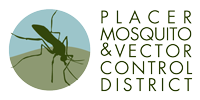
Creative technology and innovation to maximize resources is a District core value and strategic priority. We believe the right technology and innovations can help us better serve and protect public health in Placer County. We evaluate new technology through our applied research program before incorporation into regular operations.
Drones
Download the 2024 drone fact sheet.
Since 2016, the District committed to exploring unmanned aircraft systems (also known as drones) to enhance the District’s ability to perform its mission. Using drones allows the District new opportunities to control mosquito populations and update traditional techniques. We continue to evaluate our drone program and its capabilities and incorporate new tools into our operations as mosquito issues in our county grow with new threats like invasive mosquitoes and a longer mosquito season due to climate change.
OUR DRONE PROGRAM TIMELINE
Placer Mosquito is at the forefront of incorporating drones into mosquito control. Below is a timeline of steps we took to incorporate drones into everyday operations.

BENEFITS
Drones offer many benefits to our operations like a zero footprint on marsh and sensitive lands, smaller and more precise aerial treatments, improved irrigation monitoring and increased detection of mosquito larvae. Drones reduce employee safety risk, noise and fuel emissions and cost of equipment and labor. Instead of a manned aircraft that requires a pilot, drones are operated by a pilot-in-command on the ground who uses a remote transmitter, which reduces potential safety risk.
SOURCE TYPES
We use drones to treat a variety of different sources both small and large. Some of the smaller sources would include harder-to-access wetlands and some of the largest sources are organic rice in west Placer.
- Rice fields and other irrigated crops and pastures
- Irrigation ditches and basins related to agriculture, habitat, or water treatment.
- Wetlands and other naturally flooded areas
- Low areas/flooded timber
- Retention basins
- Snow melt pools
EQUIPMENT
Placer Mosquito has four active drones in its fleet, three drones are under 55 lbs. and one drone is over 55 lbs. We have four licensed Federal Aviation Administration Part 107 remote pilots and two pilots with additional Department of Pesticide Regulation licenses for aerial applications.
Hylio AG-210
Used mainly for larvicide applications, capable of using both liquid and granular formulations. Has the ability to make adulticide applications too.
- 2.5 gallon tank for liquid formulations
- 10 L Spreader for granular formulations
- 8 nozzles
- 4 motors
- Max Recommended takeoff weight 54.9 pounds
- Max operating speed 25 mph
Hylio AG-230
Used mainly for larvicide applications, capable of using both liquid and granular formulations. Has the ability to make adulticide applications too.
- 2 x 4-gallon tanks for liquid formulations
- 20 L spreader for granular formulations
- 16 nozzles
- 8 motors
- Max recommended takeoff weight 165 pounds
- Max operating speed 25 mph
DJI Matrice M210
This UAS is used to attach smaller sensors, including different cameras. Primarily used for habitat assessment missions.
DJI Mavic 2 Enterprise
This smaller UAS is used for habitat assessment missions.
NEXT STEPS & FUTURE BENEFITS
What’s next for drones in Placer County mosquito control? In collaboration with the American Mosquito Control Association Drone Program, the District continues to innovate the use of drones in mosquito control.
- Ensuring pesticide applications are safe and comply with EPA regulations.
- Evaluating more advanced missions to control mosquito larvae before they emerge into biting adults like applications over trees and vegetation.
- Enhancing ability to control adult mosquitoes in areas difficult to access by truck or manned aircraft.
- Improving worker safety, operational efficiency, and training workforce to operate and work with drone technology.
Additional UAS Resources
MAC-UAS Manuals
These manuals are intellectual property and owned by the Placer Mosquito. If you have any questions, please contact us.
Learn How Drones are Used to Control Mosquitoes from MVCAC on Vimeo.
Data Management System
The District relies on scientific data about mosquito abundance, field inspections and treatments to plan and execute preventative and responsive mosquito control operations. Since 2012, our priority has been to integrate a data management system that allows field and laboratory staff to input and receive information that assists in operational decision-making. In 2020, we upgraded our data management system to the newest version of MapVision.
Automatic Counting Adult Mosquito Traps
In 2018, the District evaluated BG-Counter automatic counting mosquito traps. This innovative device counts mosquitoes as they enter the trap and transmits mosquito counts in 15-minute intervals. This shows us when mosquitoes are most active and helps us find useful patterns to plan mosquito control treatments. The District currently has eight BG-Counters and uses them to monitor seasonality of mosquitoes, efficacy of some mosquito adulticide treatments, capture large amounts of mosquitoes needed for insecticide evaluation and establish a multi-year data set to be used for future applied research.
3D Printer
The mosquito and vector control industry has a long history of creating customized equipment and instruments to fit specific needs. 3D printing allows us to continue this tradition by creating custom parts and devices that are not available or to fabricate alternatives to items that are difficult or cost prohibitive.






